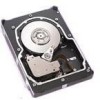Seagate 15K.3 ST373453FC Model Product Manual PDF - Page 37
Cheetah 15K.3 FC Product Manual, Rev. D, ST318453FC, Environmental limits, Temperature
 |
UPC - 000004165019
View all Seagate 15K.3 manuals
Add to My Manuals
Save this manual to your list of manuals |
Page 37 highlights
Cheetah 15K.3 FC Product Manual, Rev. D 27 ST318453FC Typical power dissipation under idle conditions in 2Gb operation is 9.6 watts (32.8 BTUs per hour). To obtain operating power for typical random read operations, refer to the following I/O rate curve (see Figure 8). Locate the typical I/O rate for a drive in your system on the horizontal axis and read the corresponding +5 volt current, +12 volt current, and total watts on the vertical axis. To calculate BTUs per hour, multiply watts by 3.4123. ST318453FC DC CURRENT/POWER vs THROUGHPUT (1Gb) Random 8 Block Reads 1.800 18.00 5Vo lt A 1.600 16.00 12 Vo lt A Watts 1.400 14.00 Amperes Power (watts) 1.200 12.00 1.000 10.00 0.800 8.00 0.600 6.00 0.400 0.0 4.00 50.0 100.0 150.0 200.0 250.0 300.0 350.0 I/Os per Second Figure 10. ST318453FC DC current and power vs. input/output operations per second 6.4 Environmental limits Temperature and humidity values experienced by the drive must be such that condensation does not occur on any drive part. Altitude and atmospheric pressure specifications are referenced to a standard day at 58.7°F (14.8°C). Maximum wet bulb temperature is 82°F (28°C). 6.4.1 Temperature a. Operating With cooling designed to maintain the case temperatures, the drive meets all specifications over a 41°F to 131°F (5°C to 55°C) drive ambient temperature range with a maximum temperature gradient of 36°F (20°C) per hour. The enclosure for the drive should be designed such that these temperatures not exceeded. Air flow may be needed to achieve these temperature values (see Section 8.4). Operation at case temperatures above these values may adversely affect the drives ability to meet specifications. The MTBF specification for the drive is based on operating in an environment that ensures that the case temperatures are not exceeded. Occasional excursions to drive ambient temperatures of 131°F (55°C) or 41°F (5°C) may occur without impact to specified MTBF. Air flow may be needed to achieve these temperatures. Continual or sustained operation at case temperatures above these values may degrade MTBF. The maximum allowable continuous or sustained HDA case temperature for the rated MTBF is 122°F (50°C). To confirm that the required cooling for the electronics and HDA is provided, place the drive in its final mechanical configuration, perform random write/read operations. After the temperatures stabilize, measure the case temperature of the drive. The maximum allowable HDA case temperature is 60°C. Operation of the drive at the maximum case temperature is intended for short time periods only. Continuous operation at the elevated temperatures will reduce product reliability.















